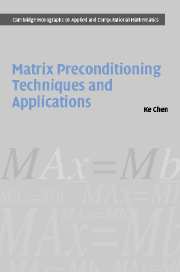Book contents
- Frontmatter
- Contents
- Preface
- Nomenclature
- 1 Introduction
- 2 Direct methods
- 3 Iterative methods
- 4 Matrix splitting preconditioners [T1]: direct approximation of An×n
- 5 Approximate inverse preconditioners [T2]: direct approximation of An×n−1
- 6 Multilevel methods and preconditioners [T3]: coarse grid approximation
- 7 Multilevel recursive Schur complements preconditioners [T4]
- 8 Sparse wavelet preconditioners [T5]: approximation of Ãn×n and Ãn×n−1
- 9 Wavelet Schur preconditioners [T6]
- 10 Implicit wavelet preconditioners [T7]
- 11 Application I: acoustic scattering modelling
- 12 Application II: coupled matrix problems
- 13 Application III: image restoration and inverse problems
- 14 Application IV: voltage stability in electrical power systems
- 15 Parallel computing by examples
- Appendix A a brief guide to linear algebra
- Appendix B the Harwell–Boeing (HB) data format
- Appendix C a brief guide to MATLAB®
- Appendix D list of supplied M-files and programs
- Appendix E list of selected scientific resources on Internet
- References
- Author Index
- Subject Index
- Plate section
14 - Application IV: voltage stability in electrical power systems
Published online by Cambridge University Press: 06 January 2010
- Frontmatter
- Contents
- Preface
- Nomenclature
- 1 Introduction
- 2 Direct methods
- 3 Iterative methods
- 4 Matrix splitting preconditioners [T1]: direct approximation of An×n
- 5 Approximate inverse preconditioners [T2]: direct approximation of An×n−1
- 6 Multilevel methods and preconditioners [T3]: coarse grid approximation
- 7 Multilevel recursive Schur complements preconditioners [T4]
- 8 Sparse wavelet preconditioners [T5]: approximation of Ãn×n and Ãn×n−1
- 9 Wavelet Schur preconditioners [T6]
- 10 Implicit wavelet preconditioners [T7]
- 11 Application I: acoustic scattering modelling
- 12 Application II: coupled matrix problems
- 13 Application III: image restoration and inverse problems
- 14 Application IV: voltage stability in electrical power systems
- 15 Parallel computing by examples
- Appendix A a brief guide to linear algebra
- Appendix B the Harwell–Boeing (HB) data format
- Appendix C a brief guide to MATLAB®
- Appendix D list of supplied M-files and programs
- Appendix E list of selected scientific resources on Internet
- References
- Author Index
- Subject Index
- Plate section
Summary
As an example of what is often called a complex system, the power grid is made up of many components whose complex interactions are not effectively computable. Accordingly, some scientists have found it more useful to study the power grid's macroscopic behaviour than to dissect individual events.
Sara Robinson. The power grid as complex system. SIAM News, Vol. 36 (2003)The electrical power network is a real life necessity all over the world; however, delivering the power supply stably while allowing various demand pattern changes and adjustments is an enormous challenge. Mathematically speaking, the beauty of such networks lies in their providing a challenging set of nonlinear differential-algebraic equations (DAEs) in the transient case and a set of nonlinear algebraic equations in the equilibrium case [438, 89, 292].
This chapter introduces the equilibrium equations, discusses some recent fast nonlinear methods for computing the fold bifurcation parameter and finally highlights the open challenge arisen from computing the Hopf bifurcation parameter, where one must solve a new system of size O(n2) for an original problem of size n. We shall consider the following.
Section 14.1 The model equations
Section 14.2 Fold bifurcation and arc-length continuation
Section 14.3 Hopf bifurcation and solutions
Section 14.4 Preconditioning issues
Section 14.5 Discussion of software and the supplied Mfiles
- Type
- Chapter
- Information
- Matrix Preconditioning Techniques and Applications , pp. 449 - 474Publisher: Cambridge University PressPrint publication year: 2005

